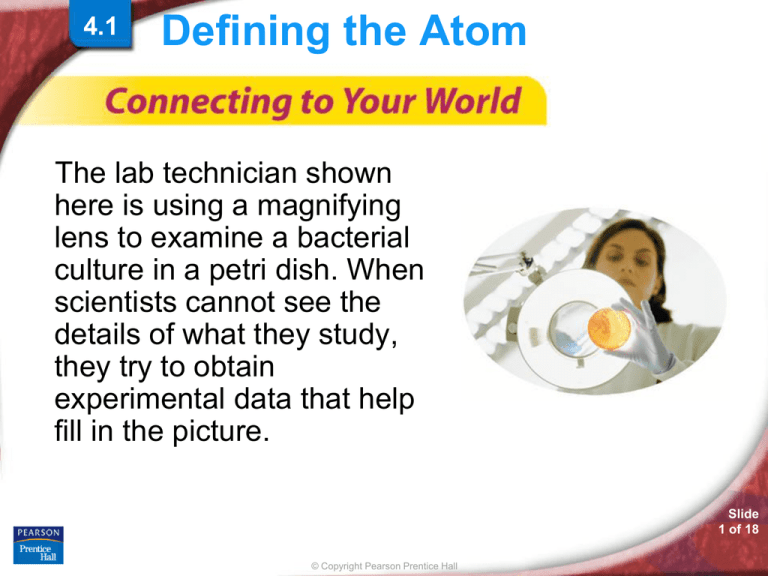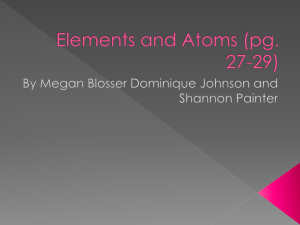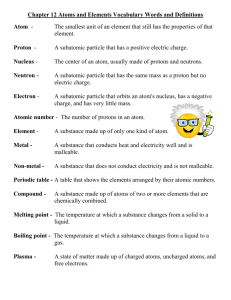
4.1
Defining the Atom
The lab technician shown
here is using a magnifying
lens to examine a bacterial
culture in a petri dish. When
scientists cannot see the
details of what they study,
they try to obtain
experimental data that help
fill in the picture.
Slide
1 of 18
© Copyright Pearson Prentice Hall
4.1
Defining the Atom
> Early Models of the Atom
Early Models of the Atom
• An atom is the smallest particle of an element
that retains its identity in a chemical reaction.
• Philosophers and scientists have proposed
many ideas on the structure of atoms.
Slide
2 of 18
© Copyright Pearson Prentice Hall
4.1
Defining the Atom
> Early Models of the Atom
Democritus’s Atomic Philosophy
How did Democritus describe atoms?
Democritus
Slide
3 of 18
© Copyright Pearson Prentice Hall
4.1
Defining the Atom
> Early Models of the Atom
Democritus believed that atoms were
indivisible and indestructible.
Democritus’s ideas were limited because
they didn’t explain chemical behavior and
they lacked experimental support.
Slide
4 of 18
© Copyright Pearson Prentice Hall
4.1
Defining the Atom
> Early Models of the Atom
Dalton’s Atomic Theory
How did John Dalton further
Democritus’s ideas on atoms?
Slide
5 of 18
© Copyright Pearson Prentice Hall
4.1
Defining the Atom
> Early Models of the Atom
By using experimental methods, Dalton
transformed Democritus’s ideas on atoms
into a scientific theory.
The result was Dalton’s atomic theory.
Slide
6 of 18
© Copyright Pearson Prentice Hall
4.1
Defining the Atom
> Early Models of the Atom
What are the theories of Dalton?
Slide
7 of 18
© Copyright Pearson Prentice Hall
4.1
Defining the Atom
> Early Models of the Atom
1. All elements are composed of tiny indivisible
particles called atoms.
Slide
8 of 18
© Copyright Pearson Prentice Hall
4.1
Defining the Atom
> Early Models of the Atom
2. Atoms of the same element are identical. The
atoms of any one element are different from
those of any other element.
Slide
9 of 18
© Copyright Pearson Prentice Hall
4.1
Defining the Atom
> Early Models of the Atom
3. Atoms of different elements can physically
mix together or can chemically combine in simple
whole-number ratios to form compounds.
Slide
10 of 18
© Copyright Pearson Prentice Hall
4.1
Defining the Atom
> Early Models of the Atom
4. Chemical reactions occur when atoms are
separated, joined, or rearranged. Atoms of one
element are never changed into atoms of
another element in a chemical reaction.
Slide
11 of 18
© Copyright Pearson Prentice Hall
4.1
Defining the Atom
> Sizing up the Atom
Sizing up the Atom
What instruments are used to observe
individual atoms?
Slide
12 of 18
© Copyright Pearson Prentice Hall
4.1
Defining the Atom
> Sizing up the Atom
Despite their small size, individual atoms
are observable with instruments such as
scanning tunneling microscopes.
Slide
13 of 18
© Copyright Pearson Prentice Hall
4.1
Defining the Atom
> Sizing up the Atom
Iron Atoms Seen Through a Scanning
Tunneling Microscope
Slide
14 of 18
© Copyright Pearson Prentice Hall
4.2
Defining the Atom
>
Subatomic Particles
Subatomic Particles
What are three kinds of subatomic particles?
Slide
15 of 18
© Copyright Pearson Prentice Hall
4.2
Defining the Atom
> Subatomic Particles
Three kinds of subatomic particles are
electrons, protons, and neutrons.
Slide
16 of 18
© Copyright Pearson Prentice Hall
4.2
Defining the Atom
> Subatomic Particles
Electrons
In 1897, the English physicist J. J. Thomson
(1856–1940) discovered the electron. Electrons
are negatively charged subatomic particles.
Slide
17 of 18
© Copyright Pearson Prentice Hall
4.2
Defining the Atom
> Subatomic Particles
Thomson performed experiments that involved
passing electric current through gases at low
pressure.
The result was a glowing beam, or cathode
ray, that traveled from the cathode to the
anode.
Slide
18 of 18
© Copyright Pearson Prentice Hall
4.2
Defining the Atom
> Subatomic Particles
Cathode Ray Tube
Slide
19 of 18
© Copyright Pearson Prentice Hall
4.2
Defining the Atom
> Subatomic Particles
A cathode ray is deflected by a magnet.
Slide
20 of 18
© Copyright Pearson Prentice Hall
4.2
Defining the Atom
> Subatomic Particles
A cathode ray is deflected by electrically
charged plates.
Slide
21 of 18
© Copyright Pearson Prentice Hall
4.2
Defining the Atom
> Subatomic Particles
Thomson concluded that a cathode ray is a
stream of electrons. Electrons are parts of
the atoms of all elements.
Slide
22 of 18
© Copyright Pearson Prentice Hall
4.2
Defining the Atom
> Subatomic Particles
Protons and Neutrons
In 1886, Eugen Goldstein (1850–1930) observed
a cathode-ray tube and found rays traveling
in the direction opposite to that of the
cathode rays. He concluded that they were
composed of positive particles.
Such positively charged subatomic particles are
called protons.
Slide
23 of 18
© Copyright Pearson Prentice Hall
4.2
Defining the Atom
> Subatomic Particles
In 1932, the English physicist James Chadwick
(1891–1974) confirmed the existence of yet
another subatomic particle: the neutron.
Neutrons are subatomic particles with no
charge but with a mass nearly equal to that of a
proton.
Slide
24 of 18
© Copyright Pearson Prentice Hall
4.2
Defining the Atom
> Subatomic Particles
Table 4.1 summarizes the properties of
electrons, protons, and neutrons.
Slide
25 of 18
© Copyright Pearson Prentice Hall
4.2
Defining the Atom
>
The Atomic Nucleus
The Atomic Nucleus
How can you describe the structure of the
nuclear atom?
Slide
26 of 18
© Copyright Pearson Prentice Hall
4.2
Defining the Atom
> The Atomic Nucleus
J.J. Thompson and others supposed the atom
was filled with positively charged material and
the electrons were evenly distributed throughout.
This model of the atom turned out to be shortlived, however, due to the work of Ernest
Rutherford (1871–1937).
Slide
27 of 18
© Copyright Pearson Prentice Hall
4.2
Defining the Atom
> The Atomic Nucleus
Rutherford’s Gold-Foil Experiment
In 1911, Rutherford and his coworkers at the
University of Manchester, England, directed a
narrow beam of alpha particles at a very thin
sheet of gold foil.
Slide
28 of 18
© Copyright Pearson Prentice Hall
4.2
Defining the Atom
> The Atomic Nucleus
Rutherford’s Gold-Foil Experiment
Slide
29 of 18
© Copyright Pearson Prentice Hall
4.2
Defining the Atom
> The Atomic Nucleus
Alpha particles scatter from the gold foil.
Slide
30 of 18
© Copyright Pearson Prentice Hall
4.2
Defining the Atom
> The Atomic Nucleus
The Rutherford Atomic Model
Rutherford concluded that the atom is mostly
empty space. All the positive charge and almost
all of the mass are concentrated in a small region
called the nucleus.
The nucleus is the tiny central core of an atom
and is composed of protons and neutrons.
Slide
31 of 18
© Copyright Pearson Prentice Hall
4.1 Section Quiz
Assess students’ understanding
of the concepts in Section 4.1.
Continue to:
-or-
Launch:
Section Quiz
Slide
32 of 18
© Copyright Pearson Prentice Hall
4.1 Section Quiz
1. The ancient Greek philosopher credited with
suggesting all matter is made of indivisible
atoms is
a. Plato.
b. Aristotle.
c. Democritus.
d. Socrates.
Slide
33 of 18
© Copyright Pearson Prentice Hall
4.1 Section Quiz
2. Dalton's atomic theory improved earlier
atomic theory by
a. teaching that all matter is composed of tiny
particles called atoms.
b. theorizing that all atoms of the same
element are identical.
c. using experimental methods to establish a
scientific theory.
d. not relating atoms to chemical change.
Slide
34 of 18
© Copyright Pearson Prentice Hall
4.1 Section Quiz
3. Individual atoms are observable with
a. the naked eye.
b. a magnifying glass.
c. a light microscope.
d. a scanning tunneling microscope.
Slide
35 of 18
© Copyright Pearson Prentice Hall
4.2 Section Quiz
1. Which of the following is NOT an example of
a subatomic particle?
a. proton
b. molecule
c. electron
d. neutron
Slide
36 of 18
© Copyright Pearson Prentice Hall
4.2 Section Quiz
2. The nucleus of an atom consists of
a. electrons only.
b. protons only.
c. protons and neutrons.
d. electrons and neutrons.
Slide
37 of 18
© Copyright Pearson Prentice Hall
4.2 Section Quiz
3. Most of the volume of the atom is occupied
by the
a. electrons.
b. neutrons.
c. protons and neutrons.
d. protons.
Slide
38 of 18
© Copyright Pearson Prentice Hall
END OF SHOW






